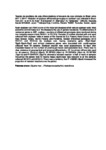Please use this identifier to cite or link to this item:
http://www.alice.cnptia.embrapa.br/alice/handle/doc/1025412Full metadata record
| DC Field | Value | Language |
|---|---|---|
| dc.contributor.author | KATO, M. | pt_BR |
| dc.contributor.author | SOARES, R. M. | pt_BR |
| dc.contributor.author | AKAMATSU, H. | pt_BR |
| dc.contributor.author | YAMANAKA, N. | pt_BR |
| dc.date.accessioned | 2015-09-30T11:11:11Z | pt_BR |
| dc.date.available | 2015-09-30T11:11:11Z | pt_BR |
| dc.date.created | 2015-09-30 | pt_BR |
| dc.date.issued | 2015 | pt_BR |
| dc.identifier.citation | In: CONGRESSO BRASILEIRO DE FITOPATOLOGIA, 48.; CONGRESSO BRASILEIRO DE PATOLOGIA PÓS COLHEITA, 2., 2015, São Pedro, SP. Fitopatologia de precisão - fronteiras da ciência: anais. [Brasilia, DF]: Sociedade Brasileira de Fitopatologia, 2015. | pt_BR |
| dc.identifier.uri | http://www.alice.cnptia.embrapa.br/alice/handle/doc/1025412 | pt_BR |
| dc.description | Asian soybean rust (ASR) is one of the important diseases which reduce soybean yield. Most economic control measure of the disease is the use of genetic resistance. To effectiveness of resistance genes to ASR, soybean reactions of differential genotypes were monitored during four cropping seasons from 2010/11 to 2013/14. Samples of leaflets infected with rust were collected from soybean fields in states of Rio Grande do Sul, Paraná, Mato Grosso do Sul, Mato Grosso, Goiás, Distrito Federal and Rondônia. Sixteen differential genotypes (18 in 2012/13 and 2013/14) for soybean rust, having resistance gene, Rpp1-Rpp6, Rpp2+Rpp4+Rpp5, and without resistance genes were inoculated with urediniospores collected from 19 samples. Soybean reaction was rated approximately 14 days after inoculation based on the number of uredinia per lesion and sporulation level. There was no clear evidence of geographical and temporal differentiation. Of the sixteen differentials used for all seasons, Shiranui (Rpp5), PI 587855 (Rpp1-b), PI 587880A (Rpp1-b), PI 587905 (Rpp1-b) and PI 594767A (Rpp1-b) showed a resistant reaction to half or more of samples throughout the period. No6-12 having Rpp2+Rpp4+Rpp5 was resistant to all the samples collected 2012/13 and 2013/14. There was a tendency that PI 459025 (Rpp4) increased the proportion of resistant reactions over the period. | pt_BR |
| dc.format | 1 CD-ROM. | pt_BR |
| dc.language.iso | eng | eng |
| dc.rights | openAccess | eng |
| dc.subject | ASR | pt_BR |
| dc.subject | Asian soybean rust | pt_BR |
| dc.title | Reação de genótipos de soja diferenciadores à ferrugem da soja coletada no Brasil entre 2011 e 2014. | pt_BR |
| dc.type | Resumo em anais e proceedings | pt_BR |
| dc.date.updated | 2018-08-21T11:11:11Z | pt_BR |
| dc.subject.thesagro | Soja | pt_BR |
| dc.subject.thesagro | Ferrugem | pt_BR |
| dc.subject.thesagro | Doença de Planta | pt_BR |
| dc.subject.nalthesaurus | Soybean rust | pt_BR |
| dc.subject.nalthesaurus | Plant diseases and disorders | pt_BR |
| dc.subject.nalthesaurus | Soybeans | pt_BR |
| riaa.ainfo.id | 1025412 | pt_BR |
| riaa.ainfo.lastupdate | 2018-08-21 -03:00:00 | pt_BR |
| dc.contributor.institution | M. KATO, JIRCAS, Japan.; RAFAEL MOREIRA SOARES, CNPSO; H. AKAMATSU, NARC, Japan.; N. YAMANAKA, JIRCAS, Japan. | pt_BR |
| Appears in Collections: | Resumo em anais de congresso (CNPSO)  | |










